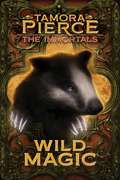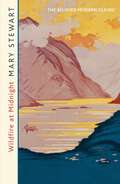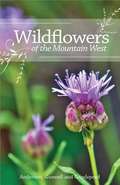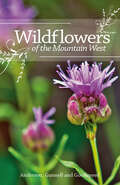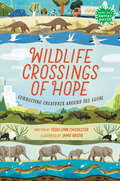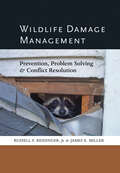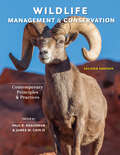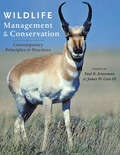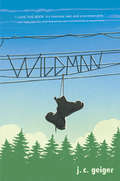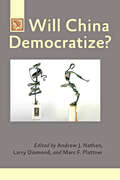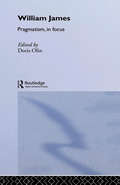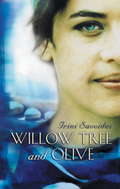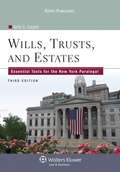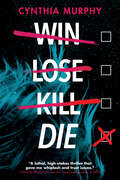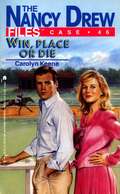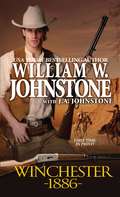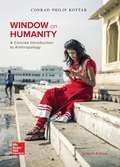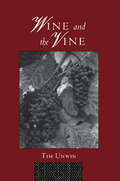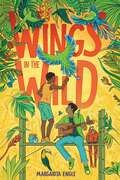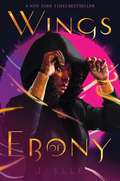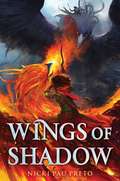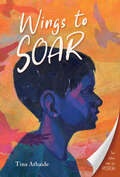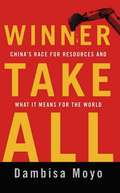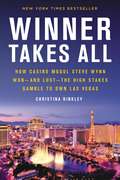- Table View
- List View
Wild Magic (The Immortals #1)
by Tamora PierceDiscover a land of enchantment, legend, and adventure in this first book of the Immortals series, featuring an updated cover for longtime fans and fresh converts alike, and including an all-new afterword from Tamora Pierce.Thirteen-year-old Daine has always had a special connection with animals, but only when she’s forced to leave home does she realize it’s more than a knack—it’s magic. With this wild magic, not only can Daine speak to animals, but she can also make them obey her. Daine takes a job handling horses for the Queen’s Riders, where she meets the master mage Numair and becomes his student. Under Numair’s guidance, Daine explores the scope of her magic. But she encounters other beings, too, who are not so gentle. These terrifying creatures, called Immortals, have been imprisoned in the Divine Realms for the past four hundred years—but now someone has broken the barrier. And it’s up to Daine and her friends to defend their world from an Immortal attack.
Wildfire at Midnight: The classic thriller you will not be able to put down (Rediscovered Classics Ser.)
by Mary Stewart'A comfortable chair and a Mary Stewart: total heaven. I'd rather read her than most other authors.' Harriet EvansFollowing a heart-breaking divorce, Gianetta retreats to the Isle of Skye hoping to find tranquillity in the island's savage beauty. But shortly before her arrival a girl's body is found on the craggy slopes of the looming Blue Mountain, and with the murderer still on the loose, there's nothing to stop him from setting his sights on Gianetta next . . . One arrogant wing of rock thrust itself across the sun, flinging a diagonal shadow over the bay. My eye was drawn to the great lonely bulk of the mountain in the east, stooping over the valley like a hawk. Blaven. The Blue Mountain.
Wildflowers of the Mountain West
by Richard M. Anderson Jerry L. Goodspeed Jay Dee GunnellMany recreational hikers have stopped along the trail to admire a wildflower only to wonder what, exactly, they are looking at. Wildflowers of the Mountain West is a useful field guide that makes flower identification easy for the general outdoor enthusiast.Many available plant guides are too technical or cumbersome for non-specialists to embrace. Covering New Mexico, Colorado, Wyoming, Idaho, Utah, Nevada and Oregon, this book is perfect for the enthusiasts who has little botanical knowledge but would like to know more about the wildflowers they are seeing. Organized by flower color for easy reference, plant records include the common and scientific names, a description of typical characteristics, habitat information and distribution maps, look-alike species, color photographs, and informative commentary. In addition, the book provides a useful introduction to the Mountain West region, along with line drawings to illustrate basic flower parts, shapes, and arrangements; a glossary of common botanical terms; a quick search key; and an index.The book is spiral-bound, making it easy to bring along while hiking, backpacking, or biking, and stunning full color photographs make visual confirmation of flower type simple and straightforward.
Wildflowers of the Mountain West
by Richard M. Anderson Jerry L. Goodspeed Jay Dee GunnellMany recreational hikers have stopped along the trail to admire a wildflower only to wonder what, exactly, they are looking at. Wildflowers of the Mountain West is a useful field guide that makes flower identification easy for the general outdoor enthusiast. Many available plant guides are too technical or cumbersome for non-specialists to embrace. Covering New Mexico, Colorado, Wyoming, Idaho, Utah, Nevada and Oregon, this book is perfect for the enthusiasts who has little botanical knowledge but would like to know more about the wildflowers they are seeing. Organized by flower color for easy reference, plant records include the common and scientific names, a description of typical characteristics, habitat information and distribution maps, look-alike species, color photographs, and informative commentary. In addition, the book provides a useful introduction to the Mountain West region, along with line drawings to illustrate basic flower parts, shapes, and arrangements; a glossary of common botanical terms; a quick search key; and an index. The book is spiral-bound, making it easy to bring along while hiking, backpacking, or biking, and stunning full color photographs make visual confirmation of flower type simple and straightforward.
Wildlife Crossings of Hope: Connecting Creatures Around the Globe (Books for a Better Earth)
by Teddi Lynn ChichesterWe all need safe places to live and safe paths to travel. Animals, too.Meet the people who are stitching the planet's habitats back together.Let&’s explore together how scientists, engineers, and lots of everyday people are working to make sure that the wildlife so essential to Earth&’s health and beauty continues to freely move through the landscapes, waterways, and skylines of this richly inhabited planet. Combining first-person reporting with research and stunning two-color art from illustrator Jamie Green, Wildlife Crossings of Hope takes a personal, in-depth look at wildlife crossings, corridor projects, and dam removal efforts around the world, from an underpass for elephants in Kenya to the Un-Dam the Klamath movement in the U.S. to the Mesoamerican Biological Corridor, which extends from southern Mexico to Panama. Above all, this is a book that invites young people to think of themselves and wildlife as part of one community that urgently needs restoration and protection. Back matter includes actions for kids to take, a complete listing of the scientific names of all creatures discussed, source notes, a bibliography, an index, and more. Books for a Better Earth™ are designed to inspire children to become active, knowledgeable participants in caring for the planet they live on.A Junior Library Guild Gold Standard Selection
Wildlife Damage Management: Prevention, Problem Solving, and Conflict Resolution
by James E. Miller Russell F. Reidinger Jr.A complete guide to preventing and resolving problems associated with wildlife-human interactions.Whether you are a student in a wildlife degree program or a professional wildlife biologist, you will find all the up-to-date information on wildlife damage in the pages of this clear, comprehensive text. Wildlife Damage Management covers every imaginable topic including:• pertinent biological and ecological concepts• individual-, population-, and ecosystem-level effects• survey techniques• management methods• human dimensions• economic issues• legal and political aspects• damage management strategiesAuthors Russell F. Reidinger, Jr., and James E. Miller explain the evolution of wildlife damage management, differentiate facts from myths, and detail the principles and techniques a professional biologist needs to know. The book discusses native as well as exotic invasive species, zoonotic diseases, hazards to endangered or threatened fauna and flora, and damage to crops, livestock, and property. Reidinger and Miller argue that, in recent years, the rate of undesirable human-wildlife interactions has risen in many areas, owing in part to the expansion of residences into places formerly wild or agricultural, making wildlife damage management even more relevant.From suburban deer eating gardens and shrubs, to mountain lions threatening pets and people, to accidentally introduced species outcompeting native species, Reidinger and Miller show how proper management can reduce wildlife damage to an acceptable, cost-effective level. An extensive section on available resources, a glossary that explains terms and concepts, and detailed figures will aid both students and seasoned professionals. Instructors will find this text arranged perfectly for a semester-long course. The end-of-chapter questions will allow students to ponder the ways wildlife damage management concepts can be put into practice. For those already working in the field—biologists and managers with federal, state, or international agencies—Wildlife Damage Management will serve as an ideal reference book. Destined to set the tone of wildlife damage conversations for the next decade and beyond, Reidinger and Miller belongs on the shelf of all wildlife professionals.
Wildlife Management and Conservation: Contemporary Principles and Practices
by Paul R. Krausman And James W. Cain IIIThe definitive textbook for students of wildlife management, now updated to cover the latest techniques, tools, and topics.Wildlife Management and Conservation presents a clear overview of the management and conservation of animals, their habitats, and how people influence both. The relationship among these three components of wildlife management is explained in chapters written by leading experts and is designed to prepare students for careers in which they will be charged with maintaining healthy animal populations. To be successful wildlife professionals, they will need to find ways to restore depleted populations, reduce overabundant, introduced, or pest species, and manage relationships among various human stakeholders. This book gives them the basic knowledge necessary to accomplish these goals.This second edition, which is updated throughout, features several new and expanded topics, including communication in the wildlife profession, fire science, Indigenous models of management and conservation, plant–animal interactions, quantitative analysis of wildlife populations, and a detailed glossary. The book also covers:• Human dimensions of wildlife management• Animal behavior• Predator–prey relationships• Structured decision making• Issues of scale in wildlife management• Wildlife health• Historical context of wildlife management and conservation• Hunting and trapping• Nongame species• Nutrition ecology• Water management• Climate change• Conservation planningThe most widely used foundational text in the field, this is the perfect resource not only for students but also for early career professionals and those in related fields who need to understand the core tenets and tools of wildlife conservation and management.Contributors: C. Jane Anderson, Bart M. Ballard, Warren B. Ballard, John A. Bissonette, Clint Boal, Scott B. Boyle, Leonard A. Brennan, Robert D. Brown, James W. Cain III, Tyler A. Campbell, Michael J. Cherry, Michael R. Conover, Daniel J. Decker, Randall W. DeYoung, Jonathan B. Dinkins, W. Sue Fairbanks, Selma N. Glasscock, James B. Grand, Michael J. Haney, James R. Heffelfinger, Scott E. Henke, Fidel Hernandez, Davie G. Hewitt, C. L. Hoving, David A. Jessup, Heather E. Johnson, Winifred B. Kessler, John L. Koprowski, Paul R. Krausman, William P. Kuvlesky, Jr., Roel R. Lopez, R. W. Mannan, Scott Mills, Michael S. Mitchell, Michael L. Morrison, Anna M. Muñoz, John F. Organ, Katherine L. Parker, William F. Porter, Shawn J. Riley, Steven S. Rosenstock, Michael C. Runge, Susan P. Rupp, William F. Siemer, Robert J. Steidl, Kelley M. Stewart
Wildlife Management and Conservation: Contemporary Principles and Practices (Wildlife Management And Conservation Ser.)
by Paul R. Krausman James W. Cain IIIA definitive textbook for students of wildlife management.Wildlife Management and Conservation presents a clear overview of the management and conservation of animals, their habitats, and how people influence both. The relationship among these three components of wildlife management is explained in chapters written by leading experts and is designed to prepare wildlife students for careers in which they will be charged with maintaining healthy animal populations; finding ways to restore depleted populations while reducing overabundant, introduced, or pest species; and managing relationships among various human stakeholders.Topics covered in this book include• The definitions of wildlife and management• Human dimensions of wildlife management• Animal behavior• Predator–prey relationships • Structured decision making• Issues of scale in wildlife management• Wildlife health• Historical context of wildlife management and conservation• Hunting and trapping• Nongame species• Nutrition ecology• Water management• Climate change• Conservation planning
Wildman
by J. C. Geiger"How can a total stranger understand you better than the people you've known your entire life?"When Lance's '93 Buick breaks down in the middle of nowhere, he tells himself Don't panic. After all, he's valedictorian of his class. First-chair trumpet player. Scholarship winner. Nothing can stop Lance Hendricks.But the locals don't know that. They don't even know his name. Stuck in a small town, Lance could be anyone: a delinquent, a traveler, a maniac. One of the townies calls him Wildman, and a new world opens up.He's ordering drinks at a roadhouse. Jumping a train. Talking to an intriguing older girl who is asking about his future. And what he really wants. As one day blurs into the next, Lance finds himself drifting farther from home and closer to a girl who makes him feel a way he's never felt before-like himself.This debut novel by a remarkable new talent explores the relationship between identity and place, the power of being seen, and the speed at which a well-planned life can change forever.
Will China Democratize? (A Journal of Democracy Book)
by Larry Diamond Andrew J. Nathan Marc F. PlattnerThis collection of articles from the Journal of Democracy considers the prospects for democracy in China.While China has achieved extraordinary economic success as it has moved toward open markets and international trade, its leadership maintains an authoritarian grip, repressing political movements, controlling all internet traffic, and opposing any democratic activity. Because of its huge population, more than half the people in the world who lack political freedom live in China. Its undemocratic example is attractive to other authoritarian regimes. But can China continue its growth without political reform? In Will China Democratize?, Andrew J. Nathan, Larry Diamond, and Marc F. Plattner present valuable analysis for anyone interested in this significant yet perplexing question.Since the Journal of Democracy’s very first issue in January 1990, which featured articles reflecting on the then-recent Tiananmen Square massacre, the Journal has regularly published articles about China and its politics. By bringing together the wide spectrum of views that have appeared in the Journal’s pages—from contributors including Fang Lizhi, Perry Link, Michel Oksenberg, Minxin Pei, Henry S. Rowen, and Nobel laureate Liu Xiaobo—Will China Democratize? provides a clear view of the complex forces driving change in China's regime and society.Whether China will democratize—and if so, when and how—has not become any easier to answer today, but it is more crucial for the future of international politics than ever before.
Will China Democratize? (A Journal of Democracy)
by Larry Diamond Andrew J. Nathan Marc F. PlattnerLeading experts on China offer their enlightening analysis on one of the most crucial and complex questions facing the future of international politics.Moving toward open markets and international trade has brought extraordinary economic success to China, yet its leadership still maintains an authoritarian grip over its massive population. From repressing political movements to controlling internet traffic, China’s undemocratic policies present an attractive model for other authoritarian regimes. But can China continue its growth without political reform? In Will China Democratize?, Andrew J. Nathan, Larry Diamond, and Marc F. Plattner present valuable analysis for anyone wondering if, when or how China might evolve politically.Since the Journal of Democracy’s very first issue in January 1990, which featured articles reflecting on the then-recent Tiananmen Square massacre, the Journal has regularly published articles about China and its politics. By bringing together the wide spectrum of views that have appeared in the Journal’s pages—from contributors including Fang Lizhi, Perry Link, Michel Oksenberg, Minxin Pei, Henry S. Rowen, and Nobel laureate Liu Xiaobo— Will China Democratize? provides a clear view of the complex forces driving change in China’s regime and society.
William James Pragmatism in Focus (Philosophers In Focus Ser.)
by Doris OlinThis book presents William James's Pragmatism together with critical commentary and focuses on the theories of meaning and truth central to Pragmatism. It includes several articles three of which were roughly contemporaneous with the publication of Pragmatism.
Willow Tree and Olive
by Irini SavvidesEnough waterwave taffeta for a lifetime of weddings, always in apricot, matching shoes and a sugared almond under your pillow so you can dream of the man you love. Olive laughs wildly and counts the expensive plates as they hit the wall. But she can't hide her desperate struggle to piece together a shattered sense of trust. Sometimes Olive is embarrassed by her culture, and even hates being Greek. But, as her friend Kerry tells her, the rest of the time she harps on as if the Greeks invented everything. Olive's parents decide that a change of scene will help her through her inability to handle school, family and growing up in general. So they send her on a holiday to Greece. And it's the Greek determination to survive, along with their love of poetry and myth, that finally encourage Olive to step out of a past she can no longer face, and take on the future.
Wills, Trusts, and Estates: Essential Tools for the New York Paralegal (3rd Edition)
by Llene S. CooperWills, Trusts, and Estates: Essential Tools for the New York Paralegal provides students everything they need to handle an estate from beginning to end, including basic terminology, intestate administration, probate proceedings, litigation, and more.
Win Lose Kill Die
by Cynthia MurphyA high-school slasher with a lethal twist, perfect for fans of Holly Jackson! The students at Morton Academy are high-achievers, selected based on academic excellence. So when a series of murders target the school's best and brightest, the pressure is on.Failure is fatal...At the historic Morton Academy, a school for high-achievers, everyone wants to be Head Girl and gain all the prestige and success that comes with the title. But when bodies start piling up, the students begin to worry that someone is too determined to take that crown.Liz, Taylor, Kat, Marcus and Cole all set out to discover what exactly is going on. Is it the secret society that they have sworn allegiance too? The history of a cult that plagues Morton Academy? Or even a greedy teacher? They need to find the truth...and quickly.
Win, Place or Die (Nancy Drew Files #46)
by Carolyn KeeneNancy goes to the Kentucky Derby -- where death is the dark horse. When Carson Drew invests in a Derby entry called Pied Piper, Nancy and Bess fly to the big event. The favorite is Toot Sweet, but during a workout an accident nearly takes the horse's jockey out of the running. Later, while racing, the jockey takes a nasty spill, and Nancy is sure the real cause is foul play. The teen sleuth sets out to track a treacherous opponent at the world-famous Run for the Roses -- only to find she's a sure thing to hit the finish line dead last.
Winchester 1886 (Winchester #1)
by William W. Johnstone J.A. JohnstoneThe Greatest Western Writer Of The 21st CenturyFrom America's most popular, bestselling Western writer, each novel in this brilliant new series follows the trail of a different gun--each gun with its own fiery story to tell. On the American frontier, every gun tells a story. A boy in Texas waits for a Christmas present he chose from a Montgomery Ward catalog. The present, a brand new, lever action Winchester 1886 and a box of its big .50-caliber slugs, never makes it there. Instead, the rifle is caught up in a train robbery and starts a long and violent journey of its own--from the hands of a notorious, kill-crazy outlaw to an Apache renegade to a hardscrabble rancher and beyond. But while the prized Winchester is wandering the West--aimed, fired, battered and bartered--Deputy U.S. Marshal Jimmy Mann is hunting for the outlaw who robbed the train in Texas. The only clue he has is this prized and highly coveted weapon. What stands in his way are storms, Indians, thieves, a lot of bloody deaths--and a merciless desperado just waiting to kill the lawman on his trail...
Window on Humanity: A Concise Introduction to Anthropology (Seventh Edition)
by Conrad Phillip KottakWindow on Humanity is intended to provide a concise, readable, introduction to general (four-field) anthropology. The shorter length increases the instructor's options for assigning additional reading--case studies, readers, and other supplements--in a semester course.
Wine and the Vine: An Historical Geography of Viticulture and the Wine Trade
by Tim UnwinVery few books have products as diverse as those of the grape vine: even fewer have products with such a cultural significance. Wine and the Vine provides an introduction to the historical geography of viticulture and the wine trade from prehistory to the present. It considers wine as both a unique expression of the interaction of people in a particular environment, rich in symbol and meaning, and a commercial product of great economic importance to particular regions.
Wings in the Wild
by Margarita EngleThis gorgeously romantic contemporary novel-in-verse from award-winning author Margarita Engle tells the &“inspiring and hopeful&” (Kirkus Reviews, starred review) love story of two teens fighting for climate action and human rights.Winged beings are meant to be free. And so are artists, but the Cuban government has criminalized any art that doesn&’t meet their approval. Soleida and her parents protest this injustice with their secret sculpture garden of chained birds. Then a hurricane exposes the illegal art, and her parents are arrested. Soleida escapes to Central America alone, joining the thousands of Cuban refugees stranded in Costa Rica while seeking asylum elsewhere. There she meets Dariel, a Cuban American boy whose enigmatic music enchants birds and animals—and Soleida. Together they work to protect the environment and bring attention to the imprisoned artists in Cuba. Soon they discover that love isn&’t about falling—it&’s about soaring together to new heights. But wings can be fragile, and Soleida and Dariel come from different worlds. They are fighting for a better future—and the chance to be together.
Wings of Ebony (Wings of Ebony)
by J. ElleInstant New York Times bestseller! &“A remarkable, breathtaking, earthshaking, poetic thrillride.&” —Daniel José Older, New York Times bestselling author of Shadowshaper In this riveting, keenly emotional debut fantasy, a Black teen from Houston has her world upended when she learns about her godly ancestry and must save both the human and god worlds. Perfect for fans of Angie Thomas, Tomi Adeyemi, and The Hunger Games!&“Make a way out of no way&” is just the way of life for Rue. But when her mother is shot dead on her doorstep, life for her and her younger sister changes forever. Rue&’s taken from her neighborhood by the father she never knew, forced to leave her little sister behind, and whisked away to Ghizon—a hidden island of magic wielders. Rue is the only half-god, half-human there, where leaders protect their magical powers at all costs and thrive on human suffering. Miserable and desperate to see her sister on the anniversary of their mother&’s death, Rue breaks Ghizon&’s sacred Do Not Leave Law and returns to Houston, only to discover that Black kids are being forced into crime and violence. And her sister, Tasha, is in danger of falling sway to the very forces that claimed their mother&’s life. Worse still, evidence mounts that the evil plaguing East Row is the same one that lurks in Ghizon—an evil that will stop at nothing until it has stolen everything from her and everyone she loves. Rue must embrace her true identity and wield the full magnitude of her ancestors&’ power to save her neighborhood before the gods burn it to the ground.
Wings of Shadow: Crown Of Feathers; Heart Of Flames; Wings Of Shadow (Crown of Feathers)
by Nicki Pau PretoIn the heart-stopping finale to the Crown of Feathers trilogy, which #1 New York Times bestselling author Kendare Blake calls &“absolutely unforgettable,&” Veronyka must face her most devastating enemy yet: her own sister.I had a sister, once… Veronyka is no longer an orphaned stable boy or a nameless Phoenix Rider apprentice: she is the daughter of Pheronia Ashfire, the last queen of the Golden Empire…and the niece of Avalkyra Ashfire, the resurrected rebel queen who tore the empire apart. We shone brightly, burned fiercely. Now that the secret is out, everyone at the Eyrie treats Veronyka differently, and with Tristan still a hostage of the scheming Lord Rolan—and Sev with him as a spy—Veronyka feels very much alone. Except for her beloved phoenix, Xephyra, of course, and her new friend, Kade, who has his own reasons for wanting to save Tristan. Was it always going to come down to this? Sister against sister? Darkness against light? Veronyka is determined to do whatever it takes to get Tristan back, even if that means revealing her identity to the world and inheriting a throne she&’s not sure she wants. But when she discovers that Avalkyra has bonded with a strix—a legendary creature of darkness that feeds off the life force of others—Veronyka realizes she has more to deal with than an encroaching war with the empire. Val is willing to destroy everything to get her revenge on a world that rejected her, and if Veronyka wants to bring peace to the empire and Pyra alike, she must face down her sister once and for all. The world began with Ashfire queens…perhaps they will also be its destruction.
Wings to Soar
by Tina AthaideA historically relevant middle-grade novel-in-verse about a girl's resiliency when faced with hatred towards refugees. Readers of The Night Diary and Inside Out and Back Again shouldn&’t miss out.It's 1972 and Viva&’s Indian family has been expelled from Uganda and sent to a resettlement camp in England, but not all of them made the trip. Her father is supposed to meet them in London, but he never shows up. As they wait for him, Viva, her mother, and her sister get settled in camp and try to make the best of their life there.Just when she is beginning to feel at home with new friends, Viva and her family move out of the camp and to a part of London where they are not welcome. While grappling with the hate for brown-skinned people in their new community, Viva is determined to find her missing father so they can finish their move to Canada. When it turns out he has been sponsored to move to the United States, they have to save enough money to join him.Told in verse, Wings to Soar follows a resilient girl and the friendships she forges during a turbulent time."These rich, vivacious lines combine an insistence on self with undaunted hope. A supreme heart-changer."—Rita Williams-Garcia, Newbery Honor, National Book Award, Boston Globe/Horn Book Award, and Coretta Scott King Award Winner
Winner Take All: China's Race for Resources and What It Means for the World
by Dambisa MoyoCommodities permeate virtually every aspect of modern daily living, but for all their importance-their breadth, their depth, their intricacies, and their central role in daily life-few people who are not economists or traders know how commodity markets work. Almost every day, newspaper headlines and media commentators scream warnings of impending doom--shortages of arable land, clashes over water, and political conflict as global demand for fossil fuels outstrips supply. The picture is bleak, but our grasp of the details and the macro shifts in commodities markets remain blurry. Winner Take All is about the commodity dynamics that the world will face over the next several decades. In particular, it is about the implications of China’s rush for resources across all regions of the world. The scale of China’s resource campaign for hard commodities (metals and minerals) and soft commodities (timber and food) is among the largest in history. To be sure, China is not the first country to launch a global crusade to secure resources. From Britain’s transcontinental operations dating back to the end of the 16th century, to the rise of modern European and American transnational corporations between the mid 1860’s and 1870’s, the industrial revolution that powered these economies created a voracious demand for raw materials and created the need to go far beyond their native countries. So too is China’s resource rush today. Although still in its early stages, already the breadth of China’s operation is awesome, and seemingly unstoppable. China’s global charge for commodities is a story of China’s quest to secure its claims on resource assets, and to guarantee the flow of inputs needed to continue to drive economic development. Moyo, an expert in global commodities markets, explains the implications of China’s resource grab in a world of diminishing resources.
Winner Takes All: How Casino Mogul Steve Wynn Wonand Lostthe High Stakes Gamble to Own Las Vegas
by Christina BinkleyFrom Pulitzer Prize-winning journalist and culture critic Christina Binkley comes an updated edition of her New York Times bestselling account of sex, drugs, and the rise of Las Vegas. With a new prologue on the rise and fall of Steve Wynn.The Strip. Home to some of the world's grandest, flashiest, and most lucrative casino resorts, Las Vegas, with its multitude of attractions, draws millions of tourists from around the world every year. But Sin City hasn't always been booming: modern Vegas exists largely thanks to the extraordinary vision, and remarkable hubris, of three competing business moguls: Kirk Kerkorian, Dr. Gary Loveman, and Steve Wynn. And in the wake of #MeToo revelations, not all empires survive.Having had personal access to all three tycoons, Binkley explains how their audacious efforts to reach the top-and to top one another-shaped the city as it stands. She takes us inside their grandest schemes, their riskiest deals, and the personalities that drove them to their greatest successes, and their most painful defeats. In this updated edition, she reveals the inside story of how Steve Wynn, the winner who took all, ultimately lost everything-twice. Sharp, insightful, and revealing, Winner Takes All is the gripping story of how billions of dollars and the unparalleled drive for power turned dreams into larger-than-life reality."It's a great drama on the greatest stage. . . Wynn, Kerkorian, and Loveman represent three opposing business personalities, three styles of achieving success. On the Vegas Strip, they're pitted against one another like gladiators, and we've got front-row seats. Kapow!" - bestselling author Po Bronson
